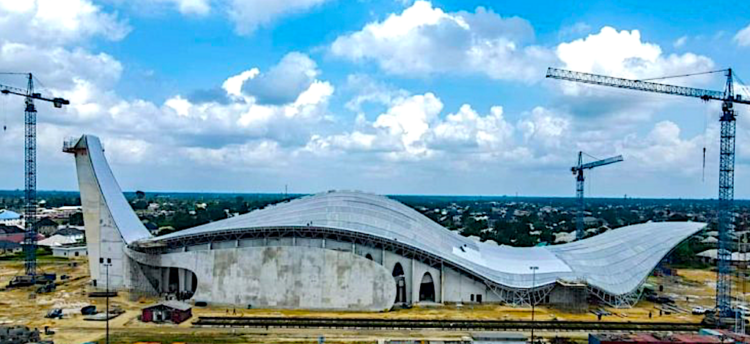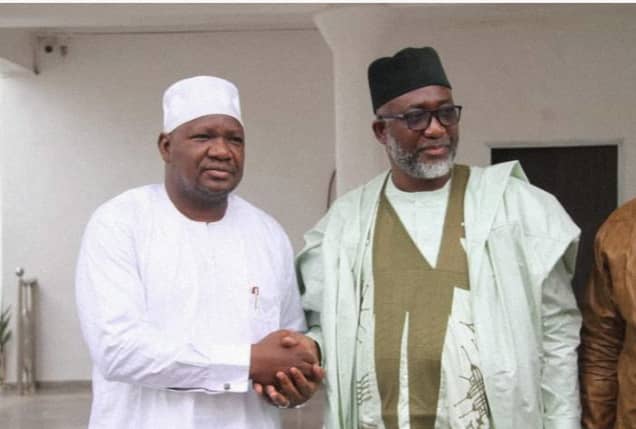One single thread links Umo Eno, self-styled pastor governor of Akwa Ibom State, his predecessor, Emmanuel Udom and Felix Houphouet-Boigny. It is the religious bigotry and senselessness behind the Akwa Ibom International Worship Centre and the Basilica of Our Lady of Peace in Yamoussoukro, Cote d’Ivoire. While Eno and Udom constructed a worship centre said to have gulped a frighteningly high N32 billion, Houphouet-Boigny also constructed a monumental architectural edifice in his Yamoussoukro village worth $300 million between 1985 and 1989. Yamoussoukro was regarded as a provincial town that boasted only a mere 220,000 inhabitants and characterized by low-density and under-utilized infrastructure. Like Eno’s Nigeria which is undergoing its major economic somersault, the 1980s when Houphouet-Boigny commissioned the construction of the Basilica was when Côte d’Ivoire sunk into a devastating recession. The Ivorian economic malaise was aggravated by falling market value of cocoa and coffee, the mainstay of the Ivorian economy.
The Basilica itself was an eye-popping spectacle of Ivorian post-independence era. Houphouet-Boigny apparently wanted to deploy its magnificence to solidify the impression of Côte d’Ivoire’s presence on the international political stage, post-independence from French colonial rule. The edifice however attracted huge flagellations from Africans and Africanists who negatively profiled Houphouet-Boigny as an “Agbelesefuja.” Highly venerated thespian, Nollywood actor and a man bountifully endowed with Yoruba proverbs, axioms and language, Chief Adedeji Aderemi, popularly known as Olofa Ina – one with a fire-spitting sword – who died last week, shed light on the concept of Agbelesefuja or what the Yoruba call “atiro b’elesin dogba”. According to Aderemi, he is the one who, buffeted by a huge self complex, tries to impress others by doing the unthinkable. Literally, the “atiro b’elesin dogba” is a man who sees a horse rider he envies and tries to equal his height while seated on the horse. To satisfy the complex of equalizing the one who sits atop the horse who he wants to best will entail huge inconveniences of standing on the toes.
Houphouet-Boigny, affectionately called Papa or Le Vieux – the Old One – by his people, was Ivorian president from 1960 to 1993 when he passed on. From being a tribal chief, he became a medical aide, union leader and thereafter, got elected to the French Parliament. In France, he served in many ministerial positions and at independence in 1960, became Ivorian first president. So, Houphouet-Boigny’s Basilica was seen from the prism of neo-coloniality and decoloniality, the one who wanted to best colonial heritage by acting as the “atiro b’elesin dogba.” First, Houphouet-Boigny maintained close ties with Ivory Coast’s former colonizer, France and maintained an open policy towards immigration to his country, which was labeled the ‘Ivorian Miracle’. Second, from 1983, he attempted to make his Yamoussoukro village, rather than Abidjan the Ivorian capital by bringing a lot of capital projects therein. Also, like the Agbelesefuja, he got a Lebanese-Ivorian architect, Pierre Fakhoury, to design an unexampled church tower in his configured Ivorian new capital as a challenging modern heritage that would rival St. Peter’s Basilica in Rome. The major challenges were that his Ivory Coast had Catholics who were a minority and the monument church got sparsely filled up on Sundays.
When the Pope consecrated his Basilica in 1990, the cost of the building was judged extreme wastage and sickening. The West Africa magazine put it at $200 million and in a banner headline in 1990 when it was being inaugurated, said, Pope Paul Consecrates a Controversial $200 million Basilica. Other analysts estimated the controversial Basilica to be worth up to $300 million. Though Houphouet-Boigny officially claimed that the Basilica was privately funded by himself, the world knew it was proceeds of diverted state funds. To worsen matters, the edifice was handed over to the Vatican as gift in 1992.
Counterpoising the affluence of the Basilica, Houphouet-Boigny’s Ivory Coast was known to be an ‘impoverished’ African country that did not deserve such an elephantine and elephant project. Indeed, Le Figaro, a French language weekly newsmagazine published in Paris and France, argued that “Africa had too many economic problems, and the last thing the continent needed was a basilica like Our Lady of Peace” which it said was grossly “reviled by many as an insult to Africa’s poor.”
The architecture of the Yamoussoukro had what Leonhard von Reinersdorff, in his “Relations Around Monumental Architecture in Post-Independence Côte d’Ivoire: Explored Through the Basilica of Our Lady of Peace in Yamoussoukro” described as “a grand dome (which) hovers over the greenery of the Ivorian forest at Yamoussoukro…offering room for 7 000 seated and 11 000 standing worshippers in the sanctuary as well as 150 000 people in an oval piazza.” According to von Reinersdorff, “the Basilica of Our Lady of Peace is one of the largest churches in the world but virtually unknown to many people.
Houphouet-Boigny’s twin aggrandizements set the tone for unflattering, condescending rhetoric that structured hard-hitting criticisms and disdain for the edifice in the western media. They also attracted unpalatable descriptions of his self-service. To them, in von Reinersdorff’s words, Yamoussoukro was “a ghost town, a capital in name alone.” Reinersdorff even quoted the Economist as calling Yamoussoukro an “an overgrown village”, “a near-deserted, forest-surrounded town of empty six-lane highways that (lead) nowhere” thus carving Houphouet-Boigny capital city in the image of a peripheral city that was conquered by nature. The West Africa magazine equally described the Basilica in very condescending epithets, especially when the Pope came to commission it. It said of it, Pope Paul Consecrates a Controversial $200 million Basilica. Beauty or Beast? The Time magazine on its own desecrated the humongous edifice as “The Basilica in the Bush” which it said was “a replica” and a “brash imitation of the Vatican’s holy shrine,” thus questioning its originality, authenticity and value of its artistic independence, caricaturing it as “a gigantic white parachute”, a “giant pearl gray dirigible” “a sandy-beige concrete behemoth” and a “ridiculous white elephant monument to Christianity”.
Fast-forward to Nigeria, about twenty years after the Pope commissioned the Yamoussoukro Basilica. A similar edifice was constructed by Akwa Ibom State. The construction of the church, named Akwa Ibom International Worship Centre, began with the former governor of the state, Udom Emmanuel and was inaugurated in May, 2023. The current governor, Eno is thus the inheritor of a Houphouet-Boigny heritage of waste, indiscretion and callous governmental insouciance. Outrage was sparked when Eno, in a tweet a few weeks back, said “As our people converge on this sacred Altar to pray in unity for the continuous peace and progress of Akwa Ibom State, Dear God Almighty, please hearken to their supplication and may our State continue to grow beyond leaps and bounds!” He spoke like one of those pastoral conmen who use the name of God to hoodwink unsuspecting Nigerians going through troublous times.
Constructed with taxpayers’ sweats to the tune of about N32 billion, many feel that in a state ravaged by squalor, hunger, underdevelopment and gross lack, were Nigeria a country where there was repercussion for governmental mis-judgment and profligacy, all those behind the construction of this wastage should be made to cough out every farthing, the product of their greed and indiscretion. It is benumbing to imagine a state spending this much to construct a church auditorium despite its huge unemployment ranking among states in Nigeria, without any regard for its oil-rich status.
In 2019, the Atheists Society of Nigeria (ASN) sued the Akwa Ibom State Government to court on the wastefulness of the church project. It demanded an explanation on how then Governor Udom would source its funding. Udom’s reply, similar to any of those pastoral hoodwinker’s, was that Akwa-Ibom had “found favour in the eyes of the Lord, and it’s instructive to note that religious bodies, non-profit organizations and even individuals from all over the world heeded our call for support to actualize this dream.” Parodying Houphouet-Boigny, Udom said that the church was privately funded. In a Nigeria where governmental purses and budgets are opaque, it may be a herculean task putting a lie to his bunkum. He had said, “Today we stand tall to say that we have secured the bulk of funds needed for the construction of the 8,500 capacity international worship centre which is located in Uyo. Government’s contribution is a very negligible percentage.”
The N32 billion Akwa Ibom International Worship Centre is a reflection of the poverty of wisdom that plagues Nigerian leaders. Another wastage was birthed last year in Kaduna State. It was the reconstruction of the popular Zaria Central Mosque. Though it wasn’t overtly penciled to be done with state funds, this same paucity of thinking was behind the over N2billion raised for the mosque’s reconstruction in October last year. The 150-year old mosque, located in the Zazzau Emirate council of Zaria, collapsed in August last year with many casualties. Of the amount donated, BUA chairman, Abdulsamad Rabiu, was said to have donated the sum of N2 billion. The fundraise also had in attendance the state governor, Uba Sani; Emir of Zazzau, Ahmed Nuhu Bamali; Sultan of Sokoto, Alh. Muhammad Sa’ad Abubakar III; former Vice President Namadi Sambo; former governors of Kaduna State, Nasir El-Rufai and Ramalan Yero; Etsu Nupe, Alh. Yahaya Abubakar and Minister of Police Affairs, Ibrahim Gaidam, who all donated various sums of money. This money could have been used to educate the growing number of out-of-school children in Kaduna State.
Aside unemployment, prostitution, cultism, vandalism, political thuggery, hooliganism that buffet Akwa-Ibom, the state is battling an age-long affliction of its citizens being the most sought after candidates for menial jobs of gatemen and house-helps in Nigeria. It is an engaging oxymoron that while Udom and Eno were busy engaged in a church saturnalia with Akwa-Ibom’s N32 bilion, thousands of Akwa Ibom young boys and girls were pining away as house-helps. Created as one of Nigeria’s 36 states in 1987, with a population of over 5 million people and more than 10 million people in the Diaspora, the state is ranked to be currently the highest oil and gas producing state in the country. Yet, this wealth notwithstanding, a recent eye-opening report by data technology company, StatiSense, in unveiling the Multidimensional Poverty Index (2022) report of the National Bureau of Statistics, (NBS) ranked Akwa Ibom, Rivers, and Cross River states as the hardest hit by multidimensional poverty, with 5.08 million, 4.4 million, and 3.44 million people respectively living in excruciating poverty.
A pure waste of resources it is expending scarce money to fund religious worship centres, Christianity, especially Pentecostal churches’ prayer warlords, have taken this menace to the level of the profoundly absurd. While companies are winding up and vacating Nigeria due to bad government, churches are filling the space by purchasing those factory halls and converting them into church auditoriums.
The problem is that Akwa-Ibom, like virtually all Nigerian states and the government at the centre, is under siege, having been bereft of straight-thinking leadership. The N32 billion expended on the Worship Centre could jolly well have been voted to deal with the menace of poverty in the state, as well as a massive job creation projects for the youth. The truth is that the N32 billion voted for the construction of the church would effectively take 32,000 Akwa Ibom persons out of poverty. Like the skewed thoughts behind the construction of gargantuan auditoriums by Pentecostal churches along expressways, inside the Akwa Ibom Worship Centre, prayers would be offered to God for jobs by the unemployed. Yet, the cost of constructing that auditorium could have provided jobs for thousands. Alternatively, the N32 billion would conveniently construct hundreds of kilometers of roads that would benefit the people immensely.
The truth is that governments have no business constructing religious worship centres or sending people on pilgrimage anywhere. The only plausible explanation for the Udom-Eno tabernacle is same Houphouet-Boigny’s reversed mentality affliction. God does not reside inside those huge Basilicas but in the hearts of His people. Except for the billions that must have been stolen by some smart politicians on the pretext of building a house for God, that worship centre has zero economic or existential impact for the suffering people of Akwa-Ibom. If the charlatans behind the Akwa Ibom International Worship Centre were pro-people, they could have selected 32,000 Akwa-Ibom house-helps in slavish captivity in many homes scattered across Nigeria and lifted them into becoming globally-competitive persons. Rather, inside the Akwa-Ibom Basilica, the people would pray for victory over their enemies. They should have known that Udo Emmanuel and Umo Eno are their Number One enemies.





